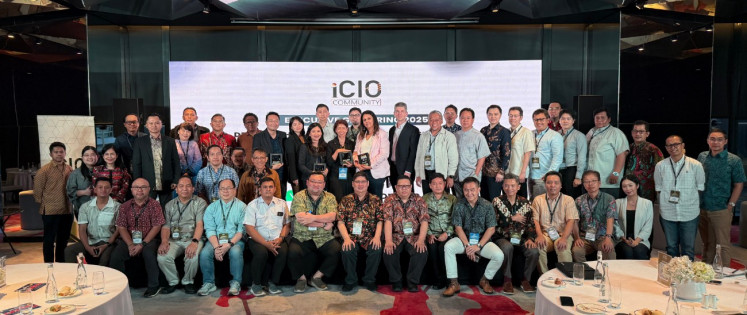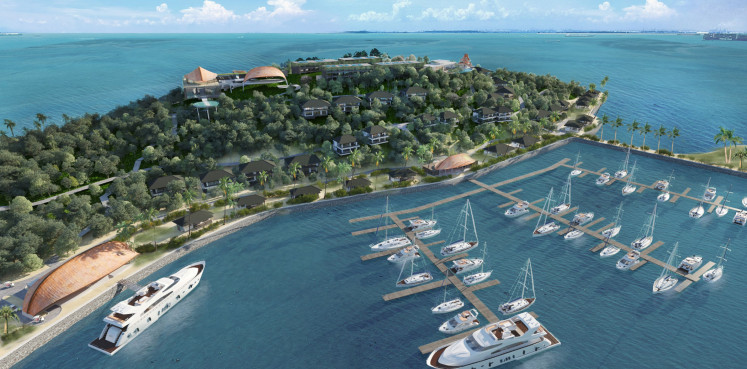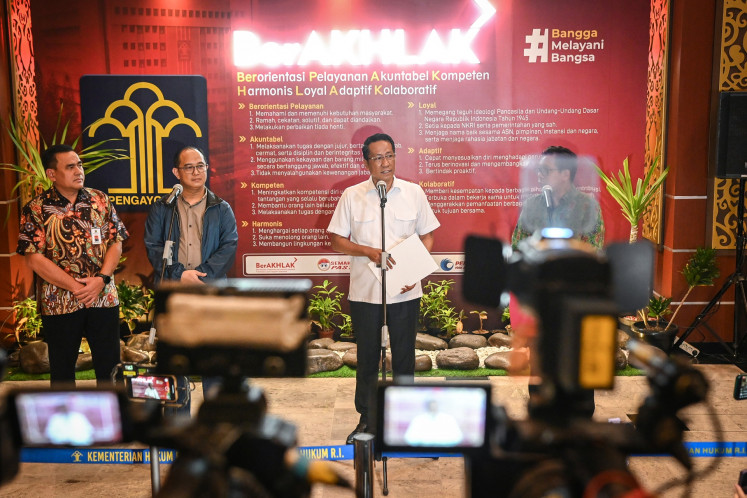Popular Reads
Top Results
Can't find what you're looking for?
View all search resultsPopular Reads
Top Results
Can't find what you're looking for?
View all search resultsPLN attracts Chinese investors to coal phase down projects
Change text size
Gift Premium Articles
to Anyone
 PLN executive vice president of corporate business development and investment Sapto Aji Nugroho (left panel) listens to a question from moderator Yose Rizal Damuri, the Centre for Strategic and International Studies (CSIS) Indonesia executive director, during a panel session at China RE Invest Indonesia 2024. (Courtesy of Tenggara Strategics)
PLN executive vice president of corporate business development and investment Sapto Aji Nugroho (left panel) listens to a question from moderator Yose Rizal Damuri, the Centre for Strategic and International Studies (CSIS) Indonesia executive director, during a panel session at China RE Invest Indonesia 2024. (Courtesy of Tenggara Strategics)
S
tate-owned electricity company PLN is offering foreign investors, especially those from China, the opportunity to participate in its decarbonization efforts to help Indonesia achieve net-zero emissions (NZE) by 2060 through the phasing-down of coal-fired power plants (CFPPs) and the deployment of more renewable energy.
Speaking at the third China RE Invest Indonesia in Jakarta, PLN executive vice president of corporate business Sapto Aji Nugroho presented Chinese investors with promising investment opportunities in a wide variety of projects, with a special emphasis on the phasing down of CFPPs.
Offering alternative investment opportunities such as CFPP phase-down projects to Chinese investors is an important step for PLN as coal phasing down is a relatively new endeavor and has been met with concern by green taxonomy authorities, especially in the West, because it can be interpreted as prolonging the use of coal for energy generation.
Sapto further explained that the CFPP phase down projects, as part of PLN’s accelerated road map for energy transition, would play a vital role in accelerating the national energy transition. Power generation by fossil fuel, especially coal, contributes the most to Indonesia’s emissions, which is why a sustainable process to phase them down is vital.
According to PLN’s scenario projection, energy transition and NZE targets would be met more efficiently by phasing down CFPPs instead of phasing them out completely. This method would provide higher energy security, thus allowing for more resources to be allocated to developing the renewable energy sector, including baseload renewable energy such as hydro and geothermal and variable renewable energy (VRE) such as solar and wind.
Under a business-as-usual scenario, PLN’s renewable generation capacity would reach 5 gigawatts through VRE sources and 17 GW through baseload new and renewable energy by 2040. Meanwhile, in the accelerated scenario, which takes into account coal phase down projects, baseload renewable energy could reach as high as 34 GW by 2040, while VRE capacity could potentially reach 28 GW by 2040.
For the VRE development targets, special emphasis is placed on the solar photovoltaic (PV) sector because of its huge potential and the rising interest of investors in solar PV, especially Chinese investors. Based on the government’s projection, Indonesia’s solar PV potential amounts to 3,294 GW, whereas current utilization has only reached 344 megawatts.
Meanwhile, according to Andriah Feby Misna, director of variable new and renewable energy and energy conservation at the Energy and Mineral Resources Ministry, the solar PV capacity target set in the 2021-2030 electricity procurement plan (RUPTL) is to reach 4.68 GW by 2030, while the road map for NZE by 2060 requires Indonesia’s solar PV capacity to reach 421 GW by 2060.
One of Indonesia’s flagship solar energy projects is the Cirata floating solar PV power plant, the third-largest in the world and with a generation capacity of 145 MW. While the investors for Cirata are Abu Dhabi Future Energy Company PJSC-Masdar and PLN, the engineering, procurement and construction (EPC) contractor for the project is Power Construction Corporation of China (PowerChina).
Masdar and PLN have agreed to develop Cirata Phase II with up to 500 MW of additional capacity, following a regulatory development from the Public Works and Housing Ministry that increased the portion of water that can be covered for renewable energy use to a maximum of 20 percent.
PLN believes that floating solar PV holds one of the highest potentials in the national solar energy sector, as Indonesia is an archipelago and floating solar PVs are able to reach isolated islands with relative ease compared with other types of power plants or expanding the electrical transmission infrastructure.
PLN and the government have identified roughly 259 locations with strong potential for floating solar PV power plants, with a cumulative solar PV potential of 14,701.71 MW, covering 20 percent of dam or reservoir surface areas. However, priority has been given to 109 locations, as they make up a majority of the solar PV potential, reaching a total of 13,898.72 MW.
PLN has also been looking into the feasibility of constructing floating solar PV power plants at existing hydro power plant dams. This implementation could potentially double the energy generation capacity of hydropower dams, which could play a large role in providing a feasible alternative to energy sourced from fossil fuels. Indonesia has a total of 162 hydropower plants with a total generation capacity of 5,998.12 MW, with some provinces such as North Sumatra being able to transition to source more of their energy consumption from hydropower compared with fossil fuels.
PLN is one of the supporters of the China RE Invest Indonesia 2024, the third edition of the multistakeholder event established by Tenggara Strategics and the Centre for Strategic and International Studies (CSIS) Indonesia with the aim of bringing together industry players from China and Indonesia to boost investment in Indonesia’s renewable energy sector.
The forum was also supported by the Energy and Mineral Resources Ministry, PT Sarana Multi Infrastruktur (SMI), the Chinese Embassy in Jakarta, the China Chamber in Jakarta, China Desk, The Jakarta Post and Prasetiya Mulya University, and saw the attendance of more than 170 offline participants in CSIS Indonesia, and more than 100 online participants representing energy companies and institutions from both China and Indonesia.
This article is written in partnership with Tenggara Strategics









